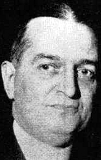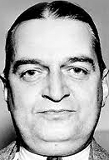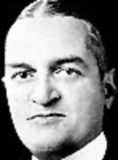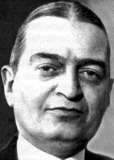Joseph Force Crater
Joseph, circa 1930
- Missing Since 08/06/1930
- Missing From Manhattan, New York
- Classification Missing
- Sex Male
- Race White
- Date of Birth 01/05/1889 (136)
- Age 41 years old
- Height and Weight 6'0, 180 pounds
- Clothing/Jewelry Description A dark brown double-breasted sack coat and matching trousers with green pinstripes, pearl-gray spats, a high White linen collar with a detachable choker, a straw panama or soft brown hat at an angle, a somewhat worn yellow gold Masonic ring, a yellow gold square wristwatch with a yellow leather strap and possibly a bow tie. He usually wore colored shirts.
- Distinguishing Characteristics White male. Graying brown hair, brown eyes. Joseph wore a full set of dentures and wore tortoiseshell eyeglasses for reading. He had a tattoo of a Sigma Chi fraternity symbol on his arm. Joseph was balding and his hair was worn parted in the middle and slicked down in 1930. The tip of his right index finger was deformed from being crushed. He had an unusually small head and neck for his size; his hat size was 6 5/8 and his collar size was 14. Joseph had a medium-dark complexion and had a tan at the time of his disappearance. His nicknames were Joe and Good Time Joe.
Details of Disappearance
Joseph was an associate justice on the New York State Supreme Court in 1930. Many people believe that he was appointed to the court because of his involvement with New York City's Tammany Hall Democratic organization. He had a scandalous history that came to light after 1930, particularly due to his association with several organized crime members and a few suspicious financial dealings.
Joseph withdrew $20,000 from the bank at approximately the same time he was appointed as interim justice to the State Supreme Court in April 1930. That amount is close to his yearly salary at the time and was considered the standard amount earned for Tammany Hall positions.
Joseph apparently used the money to become the receiver for a bankrupt hotel in New York City. He sold the building later in the year to a mortgage firm for $75,000. The city purchased the hotel two months later for nearly $3,000,000. The building was demolished due to a street-widening project.
Joseph was married to his former client Stella Mance Wheeler, whom he wed in 1917 after her divorce. He was infamous for his affairs, although many described his relationship with his wife as "devoted." The couple were residing in their summer house in Belgrade Lakes, Maine in June 1930 after the courts recessed.
Joseph received a phone call in Maine in late July and told Stella that he had to travel to New York City to "straighten those fellows out," but he assured her that it was nothing serious. He returned to Maine by August 1, after apparently stopping in Atlantic City, New Jersey with one of his girlfriends.
Joseph traveled to New York City again on August 3. He had told Stella he would be back with her within a few days, and certainly by her birthday on August 9. He had already ordered a canoe as a present for her. Stella later stated that Joseph was in a good mood and did not seem at all nervous as he packed for his trip.
When he arrived in New York, he stayed at the 5th Avenue apartment he owned with Stella. Joseph reportedly spent two hours in his office during the morning hours of August 6. He removed several files in locked briefcases and brought the papers back to his residence. Joseph's assistant told authorities that his employer cashed over $5,000 worth of checks later in the day before dismissing him.
Joseph purchased one ticket for the Broadway performance of Dancing Partner at the Belasco Theatre later that night. He arrived at Billy Haas's Chophouse in the 300 block of west 45th Street in the borough of Manhattan during the evening hours and met his friend, attorney William Klein. Joseph's girlfriend, showgirl Sally Lou Ritz, was also at the restaurant.
Witnesses stated that Joseph departed from the restaurant at approximately 9:10 or 9:15 p.m., which was after the start time of the play he planned to attend. Klein and Ritz said Joseph hailed a tan-colored taxi on west 45th Street and this is the last time they saw him, but no taxicabs reported having picked him up, and in any case the cab would have been headed in the opposite direction from Joseph's apartment. He has never been heard from again.
Stella stated she became concerned about her husband when she failed to contact him by August 16, 1930, ten days after he was last seen. She sent her chauffeur to look for him; the man searched for several days before returning to Stella and reporting that he could not find Joseph but the apartment appeared to be in order.
When Stella went to check the apartment herself, she found that none of Joseph's clothes were missing save the ones he had been wearing when he vanished, and the matching vest to the suit he had worn was still in the closet along with all of his travel bags. Joseph's monogrammed watch, pen, and card case, all of which he cherished and normally carried, were found on his dresser.
Authorities initially believed Joseph would return to New York in short order and did not begin an investigation. A search was initiated on August 25, when Joseph failed to appear at the opening of the courts.
A grand jury was convened in October 1930, nearly two months after Joseph's disappearance. Substantial evidence was collected during the investigation, but the jury members could not decide whether Joseph was deceased.
In January 1931, shortly after she moved back into the Fifth Avenue apartment for the first time since her husband's disappearance, Stella reported that she found four envelopes in their bureau.
One contained $6,690 in cash, $2,600 worth of checks Joseph had signed and made payable to himself, and three endorsed third-party checks totaling $521. The second envelope held four policies on Joseph's life, totaling $30,000, with Stella as the beneficiary. The third envelope contained Joseph's will. It had been written in 1925 and left everything he owned to Stella.
The fourth envelope in the drawer contained a three-page list in Joseph's handwriting of people and companies who owed money to him. It was apparently intended for Stella and was signed, "Love, Joe. This is all confidential." There was also a badly scrawled notation which could be read as either "Am very weary" or "I'm very sorry."
The list, judging by the due dates listed for some of the loans, had been written sometime before September 1, 1930.
Stella turned all of the papers over to the police, but not until several days after she'd found them. Investigators had thoroughly searched the apartment and the bureau five months before, and found nothing; as a result, they were of the opinion that someone had broken into the apartment and planted the envelopes in the drawer sometime after the search had concluded.
However, Stella stated that the drawer the envelopes were in was not in plain view and the authorities may have missed it. She later stated she believed Joseph had written the list of debts sometime after his disappearance, possibly while under duress, and had someone else put it in the apartment for her to find.
The apartment had been under 24-hour surveillance from September 4, 1930 until January 1931, when Stella moved back into it. There was some speculation that she had actually discovered the papers at a much earlier date than she claimed, and kept the knowledge to herself for unknown reasons, but she always maintained she found the papers in the bureau drawer in January 1931.
Stella sued several insurance companies in 1937, seven years after her husband vanished. She claimed that he had been murdered by organized crime members. The companies won the lawsuits, but Stella continued to maintain that her husband had been a victim of foul play due to his political and criminal connections.
Joseph was declared legally deceased in 1939. Stella would go on to remarry, divorce, and then write a book about her life and her husband's disappearance; the book, titled The Empty Robe, was published in 1961.
Rumors persisted that Joseph was murdered or disappeared of his accord and was living outside of the United States. There were many sightings of him all over the world and in every conceivable condition after his disappearance, but none of them were substantiated.
Authorities received a possible break in Joseph's case in 2005. A 91-year-old woman named Stella Ferrucci-Good died in April and among her effects, her relatives found an envelope marked "Do not open until my death."
Inside was a letter wherein Ferrucci-Good implicated three men in Joseph's alleged murder: her husband, a Parks Department supervisor and lifeguard who died in 1975; a New York Police officer; and the officer's brother, a cab driver.
The letter stated they had killed murdered Joseph and buried his body in Coney Island, Brooklyn, under the boardwalk near west Eighth Street. The site Ferrucci-Good named is now occupied by the New York Aquarium.
Unconfirmed reports state that the skeletal remains of five people were found there when the aquarium was built; however, all of them were buried in a potter's field with hundreds or thousands of other people's remains, and determining which of the corpses in the field came from the aquarium may be impossible.
Possible identification of the bones, if they are located, would be difficult. Joseph wore dentures, which rules out the possibility of using dental records, and he has no direct descendants living to test for DNA. His closest living relatives are his brother's grandchildren.
The phrase "pull a Crater" became popular in American culture after the justice's 1930 disappearance. It referred to people who were avoiding responsibilities or who vanished. Joseph's case is no longer under official investigation due to the passage of time.
Updated 5 times since October 12, 2004. Last updated November 11, 2006; distinguishing characteristics and details of disappearance updated.



